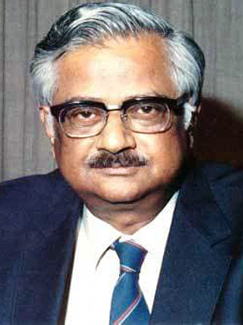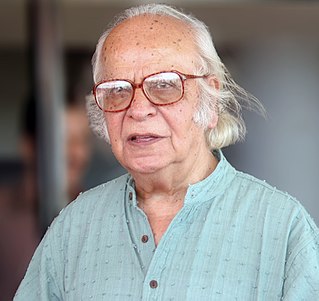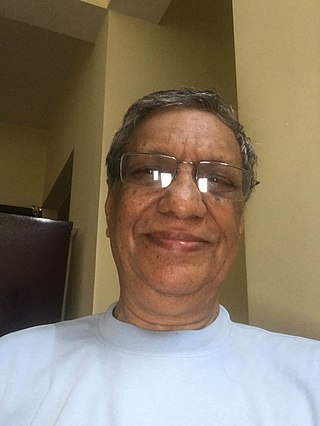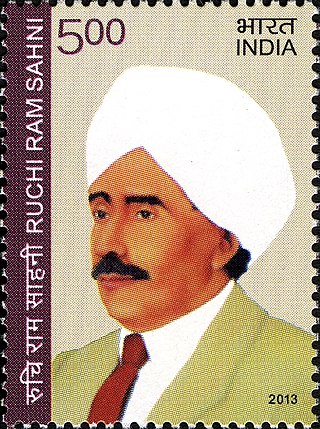Related Research Articles

Raja Ramanna was an Indian physicist who is best known for his role in India's nuclear program during its early stages.

Homi Jehangir Bhabha, FNI, FASc, FRS, Hon.FRSE was an Indian nuclear physicist who is widely credited as the "father of the Indian nuclear programme". He was the founding director and professor of physics at the Tata Institute of Fundamental Research (TIFR), as well as the founding director of the Atomic Energy Establishment, Trombay (AEET) which was renamed the Bhabha Atomic Research Centre in his honour. TIFR and AEET served as the cornerstone of the Indian nuclear energy and weapons programme. He was the first chairman of the Indian Atomic Energy Commission and secretary of the Department of Atomic Energy. By supporting space science projects which initially derived their funding from the AEC, he played an important role in the birth of the Indian space programme.

Mambillikalathil Govind Kumar Menon also known as M. G. K. Menon, was a physicist and policy maker from India. He had a prominent role in the development of science and technology in India over four decades. One of his most important contributions was nurturing the Tata Institute of Fundamental Research, Mumbai, which his mentor Homi J. Bhabha founded in 1945.

The Institute for Plasma Research (IPR) is an autonomous physics research institute in India. The institute conducts research in plasma science, including basic plasma physics, research on magnetically confined hot plasmas, and plasma technologies for industrial applications. It is a leading plasma physics organization. The institute is mainly funded by the Department of Atomic Energy. IPR plays a major scientific and technical role in Indian partnership in the international fusion energy initiative ITER. It is part of the IndiGO consortium for research on gravitational waves.
Sehgal is a Punjabi Khatri surname, originating from Punjab in India and Pakistan.

Yash Pal was an Indian scientist, educator and educationist. He was known for his contributions to the study of cosmic rays, as well as for being an institution-builder. In his later years, he became one of the leading science communicators of the country.

Rajagopala Chidambaram is an Indian Physicist who is known for his integral role in India's nuclear weapons program; he coordinated test preparation for the Pokhran-I (1975) and Pokhran-II (1998).

Piara Singh Gill was an Indian nuclear physicist and a pioneer in cosmic ray nuclear physics. He was the first Director of Central Scientific Instruments Organisation (CSIO) of India. He was research fellow of University of Chicago (1940). He was research Professorship fellow of Tata Institute of Fundamental Research (TIFR) (1947), Officer-on-Special Duty (OSD) with the Atomic Energy Commission in New Delhi. Professor and head of the Department of Physics at Aligarh University (1949), Director of Central Scientific Instruments Organization (CSIO) (1959) and Professor Emeritus at Punjab Agricultural University (1971).

Sir Kariamanikkam Srinivasa Krishnan, was an Indian physicist. He was a co-discoverer of Raman scattering, for which his mentor C. V. Raman was awarded the 1930 Nobel Prize in Physics.
Padmanabhan Krishnagopala Iyengar, was an Indian nuclear physicist who is widely known for his central role in the development of the nuclear program of India. Iyengar previously served as the director of BARC and former chairman of the Atomic Energy Commission of India, he raised his voice and opposition against the nuclear agreement between India and the United States and expressed that the deal favoured the United States.

Prem Chand Pandey is an Indian space scientist, planetary scientist, and academic in the fields of satellite oceanography, remote sensing, atmospheric science, the Antarctic and climate change, and also he is the founding director of the National Centre for Polar and Ocean Research (NCPOR).

Rakesh Kumar Popli was an Indian nuclear physicist who would establish the first Ekal Vidyalayas, or One-Teacher Schools, in remote regions of India.

Ruchi Ram Sahni was an Indian scientist and educationist active during the pre-partition era in Punjab. A pioneer meteorologist and physicist, he was the father of renowned paleobotanist Birbal Sahni.
Development and Educational Communication Unit is an arm of Indian Space Research Organisation which aims at planning and imparting training the personnel for usage of satellite based communication systems for societal needs. The main objective of the organisation is to plan and envisage satellite usage for the general population in domains such as education and medicine, as well as many others.

Valangiman Subramanian Ramamurthy is an Indian nuclear physicist with a broad range of contributions from basic research to Science and Engineering administration.Prof.Ramamurthy started his career in Bhabha Atomic Research Centre, Mumbai in the year 1963. He made important research contributions in the area of nuclear fission, medium energy heavy ion reactions, statistical and thermodynamic properties of nuclei and low energy accelerator applications. During the period 1995-2006, Prof.Ramamurthy was fully involved in Science administration as Secretary to Government of India, Department of Science and Technology, (DST), New Delhi.Other important assignments held by him include Director, Institute of Physics, Bhubaneswar, (1989-1995), DAE Homi Bhabha Chair in the Inter-University Accelerator Centre, New Delhi (2006-2010), and Director of the National Institute of Advanced Studies, Bengaluru (2009-2014). He is a former chairman of the Recruitment and Assessment Board of the Council of Scientific and Industrial Research and has served as a member of the design team of the first Indian nuclear experiment in Pokhran on 18 May 1974. The Government of India awarded him the third highest Indian civilian honour of Padma Bhushan in 2005.
Ganeshan Venkataraman is an Indian condensed matter physicist, writer and a former vice chancellor of the Sri Sathya Sai University. An elected fellow of the Indian National Science Academy, and the Indian Academy of Sciences, Venkataraman is a recipient of Jawaharlal Nehru Fellowship, Sir C. V. Raman Prize of the University Grants Commission and the Indira Gandhi Prize for Popularisation of Science of the Indian National Science Academy. The Government of India awarded him the fourth highest civilian award of Padma Shri in 1991.
Satinder Kumar Sikka was an Indian nuclear condensed matter physicist, crystallographer and a former Scientific Secretary to the Principal Scientific Advisor of the Government of India. He was known to have played a crucial role, along with Raja Ramanna, Rajagopala Chidambaram and Basanti Dulal Nagchaudhuri, in the design and development of a Hydrogen Bomb by India, which was tested at the Pokhran Test Range in May 1998, under the code name, Operation Shakthi. He was also involved in the Smiling Buddha tests, conducted in 1974. He was awarded the fourth highest civilian award of the Padma Shri, by the Government of India, in 1999.
Shyam Sunder Kapoor is an Indian nuclear physicist and a former director of Bhabha Atomic Research Centre. Known for his research on fission and heavy-ion physics, Kapoor is an elected fellow of all the three major Indian science academies – Indian Academy of Sciences, Indian National Science Academy and National Academy of Sciences, India – as well as the Institute of Physics. The Council of Scientific and Industrial Research, the apex agency of the Government of India for scientific research, awarded him the Shanti Swarup Bhatnagar Prize for Science and Technology, one of the highest Indian science awards, for his contributions to Physical Sciences in 1983.
The National Council for Science and Technology Communication (NCSTC) is a scientific programme of the Government of India for the popularisation of science, dissemination of scientific knowledge and inculcation of scientific temper. Established under the Department of Science and Technology, it "is mandated to communicate Science and Technology to masses, stimulate scientific and technological temper and coordinate and orchestrate such efforts throughout the country." Following the science communication plan introduced in the Sixth Five-Year Plan of India, NCSTC was established in 1982.
Basudeb Dasgupta is an Indian physicist who works on neutrinos and dark matter. He was awarded the Shanti Swarup Bhatnagar Prize for Science and Technology, the highest science award in India, for the year 2022 in Physical Sciences. He is also a recipient of the ICTP Prize for 2019, awarded by the International Centre for Theoretical Physics.
References
- 1 2 3 "Brief Resume of Dr Narender K. Sehgal". Vigyanteh India Computer Cell. Retrieved 15 April 2014.
- ↑ Bhatia, Sant Ram (1972). "Narender K. Sehgal". Indian Librarian. 72 (6): 197.
- 1 2 3 "Kalinga Prize laureate". UNESCO. Retrieved 15 April 2014.
- ↑ "Honorary Fellows". Indian Science Writers' Association. Retrieved 15 April 2014.